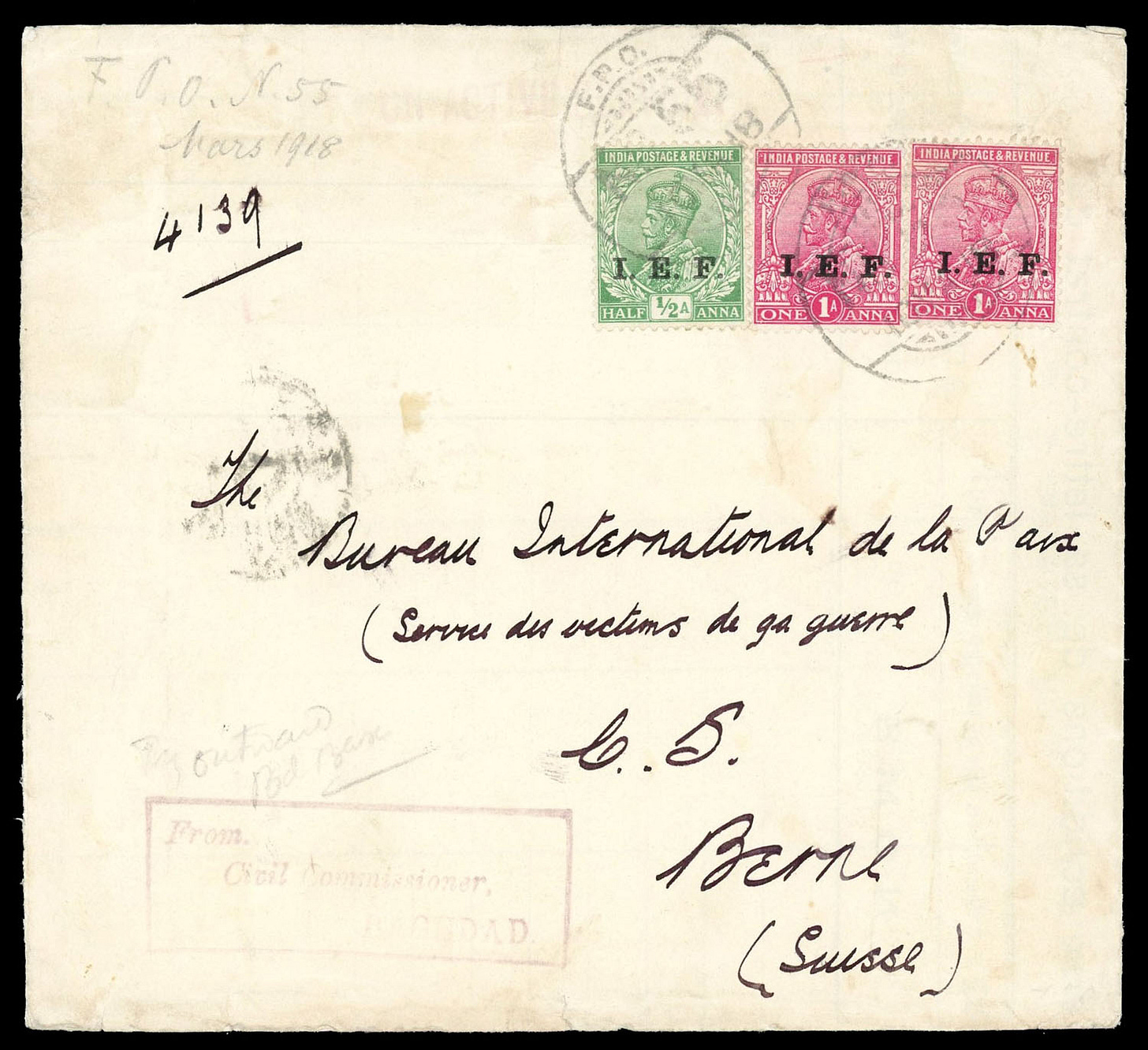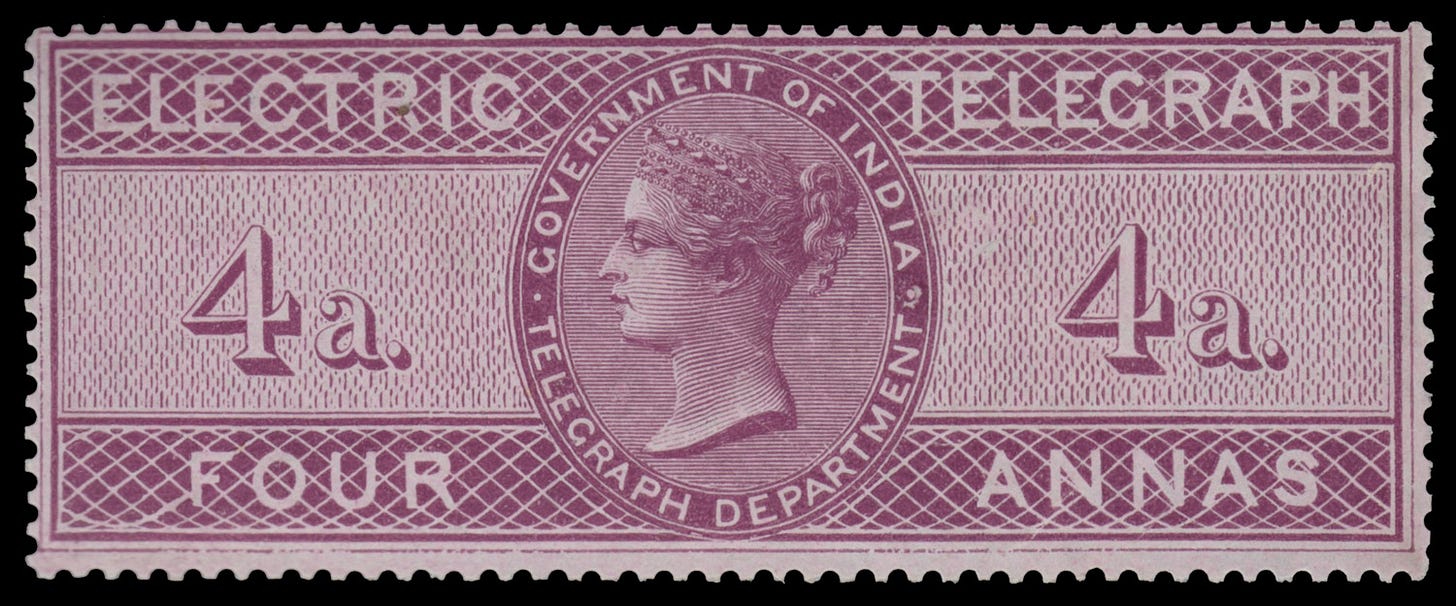Gems of India
Stampbay, in Palo Alto, Calif., will offer rarities and more affordable items this Saturday
Philately, as Deepak Jaiswal describes it, is an incurable disease, with which he has been afflicted for about 20 years. His way of dealing with it is to try and spread it to others.
He brought his passion for Indian stamps with him when he moved to California, and in 2018 started an auction house as a way of expanding his business infecting others. Stampbay has one of the stamp world’s better designed web sites, with an elegant, up-to-date interface displaying his offerings.
Stampbay’s next sale is this coming Saturday and will include live bidding on both StampAuctionNetwork and Philasearch. The lots run the gamut.
I’ll take a quick look at something fascinating in each area:
pre-stamp postal history;
India’s (and Asia’s) very first stamps, the so-called “Scinde dawks”;
British India, from the early stamps of the 1850s to independence;
mail from military campaigns;
Indian stamps used abroad, from Aden to Malaysia to Zanzibar;
airmails (did you know the world’s first airmail service was in India?);
and a very rare telegraph stamp.
Believe it or not, there are some stamp collectors who like old letters without any stamps on them. The proper term for these isn’t too hard to remember: stampless covers.

What’s their appeal? For one, they can be pretty old, predating the arrival of stamps, and they tell the story of how people communicated when doing so wasn’t all that easy, documenting rates paid, routes taken and generally how the postal service miraculously functioned even under difficult conditions.
The cover shown above was sent from a Major Graham in Dacca (nowadays Dhaka, in Bangladesh) to a sculptor in Calcutta (now Kolkata). The letter (yes, when you’re a philatelist you get to read other people’s mail) requests the change of an inscription on a statue.
Some of the markings on this cover are uncommon, giving it a desirability that merits a $450 start price.
Scinde (nowadays Sindh, in Pakistan) was the place where India’s—and indeed all of Asia’s first postage stamps were issued. The British conquered the district in 1843 and found that the old postal system of ‘dak’ (or dawk) runners was inefficient. Within a decade, they introduced a flat-rate, pre-paid mail service modeled on Rowland Hill’s reforms in the U.K. The first ½-anna stamps of 1852, with the logo of the East India Company embossed on wafers of red wax, proved too fragile, so they were soon replaced by blind-embossed white paper stamps. These, however, were a bit hard to read in the bright sunshine, so they were replaced with a blue-and-white version. All three types are elusive, the red one being the scarcest.
Their value depends largely on their condition: nice ones are highly sought after and tend to fetch a lot. Stampbay is offering two examples of the white one and two blue ones, one of which is superb and has a starting bid of $10,000.
As Britain contemplated expanding the use of stamps throughout India, various design essays were prepared. Several of these are featured in the sale.

One of my favorite is the unadopted lion and palm tree essay of 1853. The Calcutta Mint later reprinted this sample design in various colors in a very limited edition. This design was set aside in favor of a design showing Queen Victoria, modeled on the Penny Red stamp of Great Britain.

In yesterday’s newsletter, I mentioned that not many countries issued stamps to the public without gum; Afghanistan was one example. India, in the early days, was another: the sub-tropical weather made distribution of ready-gummed stamps impractical. The stamp shown above is a beautiful, mint example of India’s first national issue, in 1854. It came without gum.
India finally achieved independence 75 years ago, in 1947. The great, nonviolent architect of that independence, Gandhi, was tragically assassinated in Jan. 1948; to commemorate the first anniversary of independence, the Indian post office put out a set of four stamps paying tribute to “the great patriot.” This issue, particularly the 10-rupee high value, is one of the most popular issues of India and FDCs bearing the full set are in great demand.
The British made extensive use of their Indian army, both for fighting and peacekeeping. In 1918, Britain occupied the former Ottoman province of Mesopotamia, later renamed Iraq. Indian troops were sent to occupy and keep order. India managed the postal system throughout much of the Persian Gulf region, and Indian stamps were used on mail in many places outside of India. To keep things organized, stamps for use by the Indian Expeditionary Force in Baghdad were overprinted “I.E.F.”—shown above is an example of mail franked with them.

Beyond the Persian Gulf and Arabian Gulf, stamps of India were also pressed into use as far away as East Africa and Malaysia, largely thanks to the historical trading ties between India and those places and their existing use of Indian currency. The first stamps of Zanzibar and of Malaysia’s Straits Settlements were Indian issues, provisionally overprinted, like the ¼-anna Queen Victoria postal card shown above.
India was the scene of the world’s first airmail service, in 1911, in Allahabad (Prayagraj), and the Stampbay sale includes a cover flown in that exhibition and then sent onward to Germany. It also includes a number of experimental rocket-mail covers of the 1930s and 40s.

These were created for fun by collectors, but they did legitimately pass through the postal system, as evidenced by the canceled King George V 9-pies stamp. Experiments like this took place all around the world, from land and from ships, and they form a small but enthusiastically pursued collecting field.
India’s telegraph system eventually became well developed and heavily used, but at the outset, in the 1850s, that was not the case. The first issue of 1857, with stamps inscribed “Electric Telegraph,” was little publicized and heavy restrictions were placed on the stamps’ use, according to Stanley Gibbons. As a result just 16 mint examples of the 4a stamp, shown above, are recorded as having survived (and just five used examples), with some in institutional collections and therefore unavailable to you and me. Needless to say, this is a rare opportunity to acquire one of these purple beauties.
Stampbay’s sale begins Saturday, Aug. 20 at 10 am EDT (7 am PDT). Live bidding online at StampAuctionNetwork and Philasearch. Buyer’s premium is 18 percent; read the Terms and Conditions carefully before bidding and familiarize yourself with bidding increments.
Til tomorrow,








